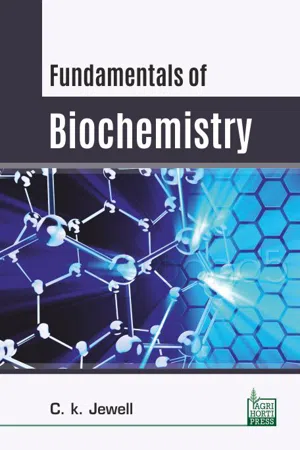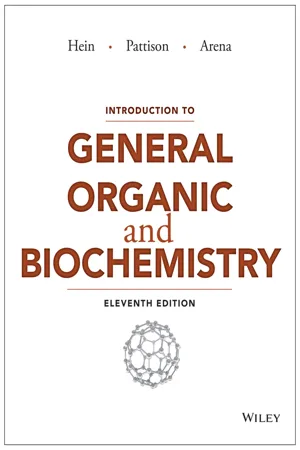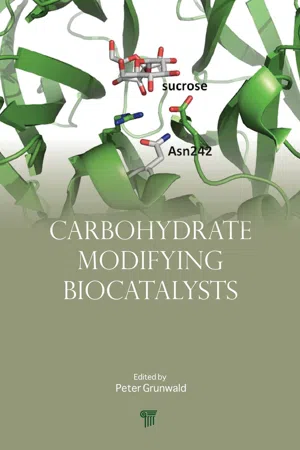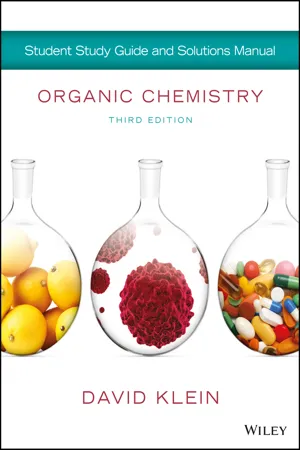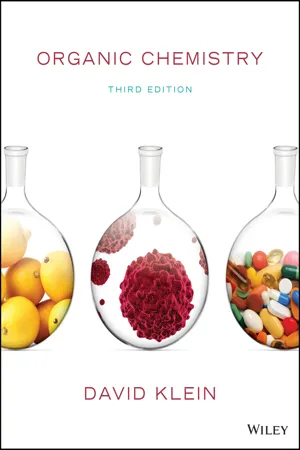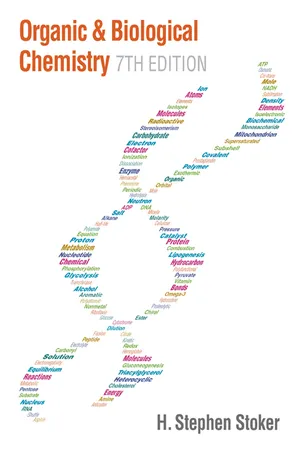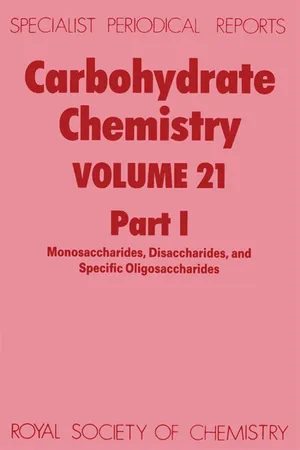Chemistry
Aldose vs Ketose
Aldose and ketose are two types of monosaccharides, which are simple sugars. The main difference between them lies in their functional group: aldoses have an aldehyde group, while ketoses have a ketone group. This structural difference affects their chemical properties and reactivity. Both aldoses and ketoses play important roles in biological processes and are fundamental building blocks of carbohydrates.
Written by Perlego with AI-assistance
Related key terms
1 of 5
9 Key excerpts on "Aldose vs Ketose"
- eBook - PDF
- Jewell, C K(Authors)
- 2018(Publication Date)
- Agri Horti Press(Publisher)
This compound was L-(+)-gulose and its exchange relationship to D-(+)-glucose was demonstrated be oxidation to a common aldaric acid product. KETOSES If a monosaccharide has a carbonyl function on one of the inner atoms of the carbon chain it is classified as a ketose. Dihydroxyacetone may not be a sugar, but it is included as the ketose analog of glyceraldehyde. The carbonyl group is commonly found at C-2, as illustrated by the following examples (chiral centers are colored red). As expected, the carbonyl function of a ketose may be reduced by sodium borohydride, usually to a mixture of epimeric products. D-Fructose, the sweetest of the common natural sugars, is for example reduced to a mixture of D-glucitol (sorbitol) and D-mannitol, named after the aldohexoses from which they may also be obtained by analogous reduction. Mannitol is itself a common natural carbohydrate. Although the ketoses are distinct isomers of the aldose monosaccharides, the chemistry of both classes is linked due to their facile interconversion in the presence of acid or base catalysts. This interconversion and the corresponding epimerization at sites alpha to the carbonyl functions, occurs by way of an enediol tautomeric intermediate. Because of base-catalyzed isomerizations of this kind, the Tollens’ reagent is not useful for distinguishing aldoses from ketoses or for specific oxidation of aldoses to the corresponding aldonic acids. Oxidation by HOBr is preferred for the latter conversion. This ebook is exclusively for this university only. Cannot be resold/distributed. 48 Fundamentals of Biochemistry ANOMERIC FORMS OF GLUCOSE Fischers brilliant elucidation of the configuration of glucose did not remove all uncertainty concerning its structure. Two different crystalline forms of glucose were reported in 1895. Each of these gave all the characteristic reactions of glucose and when dissolved in water equilibrated to the same mixture. - Morris Hein, Scott Pattison, Susan Arena, Leo R. Best(Authors)
- 2014(Publication Date)
- Wiley(Publisher)
Their structures contain the carbonyl group, C O , a carbon–oxygen double bond. Aldehydes have at least one hydrogen atom bonded to the carbonyl group, whereas ketones have only alkyl or aryl (aromatic, denoted Ar) groups bonded to the carbonyl group: Ar C H O C Ar O ketones R C H O aldehydes C R O R R C Ar O Ar In a linear expression, the aldehyde group is often written as CHO. For example, CH 3 C H O CH 3 CHO is equivalent to In the linear expression of a ketone, the carbonyl group is written as CO. For example, CH 3 CCH 3 O CH 3 COCH 3 is equivalent to The general formula for the saturated homologous series of aldehydes and ketones is C n H 2n O. KEY TERMS carbonyl group aldehyde ketone A second hydrogen atom bonded to a carbonyl group occurs in only one compound; formaldehyde. A Biochemical Perspective: Carbohydrates contain carbonyl groups: They can be either aldehydes or ketones. LEARNING OBJECTIVE TABLE 23.1 Why Are Aldehydes and Ketones Important to Biochemistry? Answer Comment #1 Because carbohydrates are aldehydes and ketones, they can form polymers. Starches and cellulose exist because of the special reactivity of the carbonyl group. #2 The genetic code is bonded in place by an important carbonyl group reaction. The well-known genetic code is a sequence of bases [adenine (A), guanine (G), thymine (T), cytosine (C)] connected to a “backbone.” The carbonyl group provides the connection. #3 The carbonyl group enables carbohydrates to form their most common structures—rings. Almost all common carbohydrate monomers exist as rings. 23.2 NAMING ALDEHYDES AND KETONES Be able to write names and structures for both aldehydes and ketones. Aldehydes IUPAC RULES FOR NAMING ALDEHYDES 1. To establish the parent name, select the longest continuous chain of carbon atoms that contains the aldehyde group. 2. The carbons of the parent chain are numbered starting with the aldehyde group. Since the aldehyde group is at the beginning (or end) of a chain, it is always number 1.- eBook - PDF
- Peter Grunwald(Author)
- 2011(Publication Date)
- Jenny Stanford Publishing(Publisher)
In general, the carbonyl group can be oxidized or reduced or react with nucleophiles. 1.3.1 Oxidation of carbohydrates Basically, both aldoses and ketoses may be oxidized to aldonic acids. However, if a mild oxidizing agent such as bromine is applied, exclusively the aldehyde group is being oxidized. Thus aldoses can be discriminated from ketoses by adding an aqueous solution of bromine to the sugar solution. If the monosaccharide is an aldose, the red-brown bromine colour will disappear, indicating the oxidation of the aldehyde function (Fig. 1.13), while the colour will persist if the unknown sugar is a ketose. C O H OH H OH H OH H CH 2 OH HO H + Br 2 H 2 O OH H OH H OH H CH 2 OH HO H COOH Br + -2 D Glucose bromine (red brown) D Gluconic acid bromide (colourless ) Figure 1.13 Mild oxidation of d -glucose by bromine. In the presence of stronger oxidizing agents such as Tollens reagent both aldoses and ketoses are oxidized to aldonic acids. This is insofar remarkable, as Tollens reagent is known to react with aldehydes, but not with ketones. This contradiction between the 17 reactions with ketones and ketoses can be explained as follows: as Tollens reaction is carried out under basic conditions, an enolization may take place that leads to an equilibration between aldehyde/ enol/keto forms. As an example, this enolization equilibrium is shown for the system glucose/enol/fructose in Fig. 1.14. Tollens reaction is a well-known analytical tool for distinguishing between reducing and non-reducing carbohydrates (“silver mirror test”). For demonstrations in experimental lessons of basic organic chemistry, use of fructose instead of glucose can be recommended, because the “silver mirror” thus obtained is brighter, if the ketose is applied. Glucose enol tautomer Fructose Figure 1.14 Enolization of glucose and fructose under basic conditions in aqueous solution. Another well-known analytical test for the verification of reducing sugars is the so-called Fehling reaction. - eBook - PDF
- David R. Klein(Author)
- 2021(Publication Date)
- Wiley(Publisher)
Complex sugars, such as disaccharides and polysaccharides, are made by joining monosac- charides together, and they will be discussed in Sections 24.7 and 24.8. Monosaccharides generally contain multiple chiral centers, and Fischer projections are used to indicate the configuration at each chiral center. Glucose and fructose are two examples of simple sugars. C OH H H HO OH H OH H CH 2 OH O H Glucose CH 2 OH C O H HO OH H OH H CH 2 OH Fructose LOOKING BACK For a review of Fischer projections and the skills necessary to interpret these drawings refer to Section 5.7. 24.2 Classification of Monosaccharides 1155 The suffix -ose is used to signify a carbohydrate. Hundreds of different monosaccharides are known, each of which can generally be classified as either an aldose or a ketose. Aldoses contain an aldehyde group, while ketoses contain a ketone group. According to this classification scheme, glucose is an aldose and fructose is a ketose. Aldoses and ketoses can be further classified based on the number of carbon atoms they con- tain. This is accomplished by inserting a term (tri-, tetr-, pent-, hex-, or hept-) immediately before the suffix -ose. An aldopentose C OH H OH H OH H CH 2 OH H O 1 2 3 4 5 A ketohexose CH 2 OH C O OH H OH H OH H CH 2 OH 6 1 2 3 4 5 The first compound is an aldose with five carbon atoms, and it is therefore called an aldopentose. The second compound is a ketose with six carbon atoms, and it is therefore called a ketohexose. In this way, carbohydrates are classified using three descriptors: 1. aldo or keto, indicating whether the compound is an aldehyde or a ketone 2. tri-, tetr-, pent-, hex-, or hept-, indicating the number of carbon atoms 3. -ose, indicating a carbohydrate D and L Sugars Glyceraldehyde is one of the smallest compounds considered to be a carbohydrate. It has only one chiral center and therefore can exist as a pair of enantiomers. - eBook - PDF
Penta- and Higher Polyhydric Alcohols, Their Oxidation Products and Derivatives, Saccharides
A Modern Comprehensive Treatise
- S. Coffey(Author)
- 2013(Publication Date)
- Elsevier(Publisher)
Chapter 23 The Monosaccharides: Pentoses, Hexoses, Heptoses and Higher Sugars L. HOUGH AND A. C. RICHARDSON 1. Monosaccharides The monosaccharides may be described as oxidation products of alditols but more precisely as polyhydroxy compounds with aldehydic or ketonic characteristics. They dissolve freely in water to give optically active colour-less solutions which are oxidised under mild conditions by alkaline oxidising agents, such as Fehling's solution and ammoniacal silver nitrate. The names aldose and ketose are used in a generic sense to denote the character of the carbonyl group of a monosaccharide. Whilst the monosaccharides do occur free in nature, they are more often encountered in a combined form in natural products, such as polysaccharides, oligosaccharides, glycosides etc., from which they are liberated by hydrolysis with aqueous mineral acids or enzymes. More than a hundred monosaccharides occur in nature, and some play a predominant and dynamic role in essential biochemical processes, usually in the form of phosphate ester derivatives. Plants perform one of the most funda-mental processes in biochemistry, namely photosynthesis, by converting vast quantities of atmospheric carbon dioxide into carbohydrate materials in the presence of light. As a result, enormous quantities of glucose are laid down as units of starch (p. 677) and of cellulose (p. 672), a natural polymer that is the most abundant of all organic substances occurring in nature. Carbohydrates owe their early discovery to the characteristic sweet taste of certain members and to their value as foodstuffs. The relatively high crystallinity of cane sugar (sucrose) must have made it one of the first known crystalline carbohydrates. It became a product of commerce as early as the 18th century. Glucose must also have been known to the ancients because of its occurrence in granulated honey and wine musts. References to grape sugar (glucose) are to be - David R. Klein(Author)
- 2017(Publication Date)
- Wiley(Publisher)
Chapter 24 Carbohydrates Review of Concepts Fill in the blanks below. To verify that your answers are correct, look in your textbook at the end of Chapter 24. Each of the sentences below appears verbatim in the section entitled Review of Concepts and Vocabulary. Carbohydrates are polyhydroxy ___________ or ketones. Simple sugars are called _______________ and are generally classified as aldoses and _________. For all D sugars, the chiral center farthest from the carbonyl group has the ___ configuration. Aldohexoses can form cyclic hemi______ that exhibit a pyranose ring. Cyclization produces two stereoisomeric hemiacetals, called ___________. The newly created chiral center is called the ___________ carbon. In the α anomer, the hydroxyl group at the anomeric position is ______ to the CH 2 OH group, while in the β anomer, the hydroxyl group is ______ to the CH 2 OH group. Anomers equilibrate by a process called _____________, which is catalyzed by either ______ or _______. Some carbohydrates, such as D-fructose, can also form five-membered rings, called ___________ rings. Monosaccharides are converted into their ester derivatives when treated with excess _____________________________. Monosaccharides are converted into their ether derivatives when treated with excess ___________________ and silver oxide. When treated with an alcohol under acid-catalyzed conditions, monosaccharides are converted into acetals, called ___________. Both anomers are formed. Upon treatment with sodium borohydride an aldose or ketose can be reduced to yield an ___________. When treated with a suitable oxidizing agent, an aldose can be oxidized to yield an __________. When treated with HNO 3 , an aldose is oxidized to give a dicarboxylic acid called an _______________. D-Glucose and D-mannose are epimers and are interconverted under strongly __________ conditions. The Kiliani-Fischer synthesis can be used to lengthen the chain of an ________.- eBook - PDF
- David R. Klein(Author)
- 2016(Publication Date)
- Wiley(Publisher)
However, a small amount of the open-chain form is present at equi- librium, and it is the aldehyde group of the open-chain form that reacts with the oxidizing agent to produce an aldonic acid. As the open-chain form of glucose is converted into the aldonic acid, the equilibrium is perturbed. This causes more of the glucose molecules to adopt an open-chain form, which then undergo oxidation, a process that continues until nearly all of the glucose molecules have been oxidized. The oxidizing agent above will oxidize aldoses but does not react with ketoses. A ketose lacks the aldehydic hydrogen that is characteristic of an aldose. R H O An aldose R CH 2 OH O A ketose It is true that ketoses slowly equilibrate with aldoses via a process that is similar to epimerization, and we might therefore expect that a small concentration of the ketose would be converted into an aldose, which would then undergo oxidation, providing a pathway for the ketose to be oxidized as well. However, the mildly acidic conditions employed (a buffered solution of pH = 6) prevent isom- erization from occurring. Under these conditions, a ketose does not undergo isomerization to give an 24.6 Reactions of Monosaccharides 1125 aldose at an appreciable rate, and ketoses are therefore not oxidized by a buffered solution of aqueous bromine. This, in fact, provides a method for distinguishing between aldoses and ketoses. In contrast, there are other oxidizing agents that employ conditions under which isomerization can occur. These alternative reagents can oxidize ketoses as well as aldoses. Examples of such oxidizing agents include the Tollens’ reagent (Ag + in aqueous ammonia), Fehling’s reagent (Cu 2+ in aqueous sodium tartrate), and Benedict’s reagent (Cu 2+ in aqueous sodium citrate). All three can be used as chemical tests for the presence of an aldose or ketose. - eBook - PDF
- H. Stephen Stoker(Author)
- 2015(Publication Date)
- Cengage Learning EMEA(Publisher)
Cengage Learning reserves the right to remove additional content at any time if subsequent rights restrictions require it. 4-3 The Aldehyde and Ketone Functional Groups 131 4-3 The Aldehyde and Ketone Functional Groups L E A R N I N G F O C U S Know the structural features that distinguish aldehydes from ketones; know the structural nota-tions used to denote aldehyde and ketone functional groups. An aldehyde is a carbonyl-containing organic compound in which the carbonyl car-bon atom has at least one hydrogen atom directly attached to it. The remaining group attached to the carbonyl carbon atom can be hydrogen, an alkyl group (R), a cycloal-kyl group, or an aryl group (Ar). ▶ The aldehyde functional group is H C O O B Linear notations for an aldehyde functional group and for an aldehyde itself are ! CHO and RCHO, respectively. Note that the ordering of the symbols H and O in these notations is HO, not OH (which denotes a hydroxyl group). The C in the nota-tion RCHO is the carbonyl carbon atom. It is bonded to the R group (single bond), the H atom (single bond), and the O atom (double bond). A ketone is a carbonyl-containing organic compound in which the carbonyl carbon atom has two other carbon atoms directly attached to it. The groups containing these bonded carbon atoms may be alkyl, cycloalkyl, or aryl. ◀ The ketone functional group is C O O C O C O O B The general condensed formula for a ketone is RCOR, in which the oxygen atom is understood to be double-bonded to the carbonyl carbon at the left of it in the for-mula. If both R groups of the ketone are the same, the notation R 2 CO is often used. An aldehyde functional group can be bonded to only one carbon atom because three of the four bonds from an aldehyde carbonyl carbon must go to oxygen and hydrogen. Thus an aldehyde functional group is always found at the end of a carbon chain. ◀ A ketone functional group, by contrast, is always found within a carbon chain, as it must be bonded to two other carbon atoms. - eBook - PDF
Carbohydrate Chemistry
Volume 21
- N R Williams(Author)
- 2007(Publication Date)
- Royal Society of Chemistry(Publisher)
X Carbohydrate Chemistry Chapter 15 Aldosuloses, Dialdoses, and Diuloses 150 150 1 Aldosuloses 2 Dialdoses 151 3 Diuloses 152 153 References Chapter 16 Sugar Acids and Lactones 154 154 1 General 2 Aldonic Acids 154 3 Saccharinic Acids 157 158 4 Ulosonic Acids 161 5 Uronic Acids 6 Ascorbic Acids 162 7 Aldaric Acids 164 165 References Chapter 17 Inorganic Derivatives 167 167 1 Carbon-bonded Phosphorus Derivatives 2 Other Carbon-bonded Derivatives 167 3 Oxygen-bonded Derivatives 168 170 References 172 Chapter 18 Alditols and Cyclitols 1 Alditols Acyclic Alditols Anhydro-inositols Branched-chain Alditols Amino-alditols Heterocyclic Derivatives Miscellaneous Compounds 172 172 174 175 175 177 178 2 Cyclitols Inositols Amino-inositols Branched-chain Inositols Inositol Phosphates Miscellaneous Cyclitols 178 178 179 180 183 183 184 References X I Contents C h a p t e r 19 Antibiotics 1 Amino-glycoside Antibiotics 2 Macrolide Antibiotics 3 Anthracycline and Related Polycyclic Antibiotics 4 Nucleoside Antibiotics 5 Glycopeptide Antibiotics 6 Miscellaneous Antibiotics 187 187 189 190 191 195 195 References 197 C h a p t e r 20 Nucleosides 1 Synthesis 2 Anhydro- and Cyclo-nucleosides 3 Deoxynucleosides 4 Halonucleosides 5 Amino- and Azido-nucleosides 6 Thionucleosides 7 Branched-chain Nucleosides 201 201 203 205 207 208 209 209 8 Nucleosides of Unsaturated Sugars, Keto-sugars, and Uronic Acids 210 9 C-Nucleosides 211 10 Carbocyclic Nucleoside Analogues 212 11 Nucleoside Phosphates and Phosphonates 214 12 Ethers of Nucleosides 216 13 Esters and Acetals of Nucleosides 14 Reactions 216 218 15 Spectroscopic and Conformational Studies 219 References 219 Chapter 21 N.M.R. Spectroscopy and Conformational Features 1 Theoretical and General Considerationso 2 2 5 225 226 226 2 Acyclic Systems 3 Furanose Systems xii Carbohydrate Chemistry Chapter 22 Chapter 23 1 2 3 Chapter 24 Author Index Pyranose Systems Oligosaccharides and Related Compounds N.M.R.
Index pages curate the most relevant extracts from our library of academic textbooks. They’ve been created using an in-house natural language model (NLM), each adding context and meaning to key research topics.
